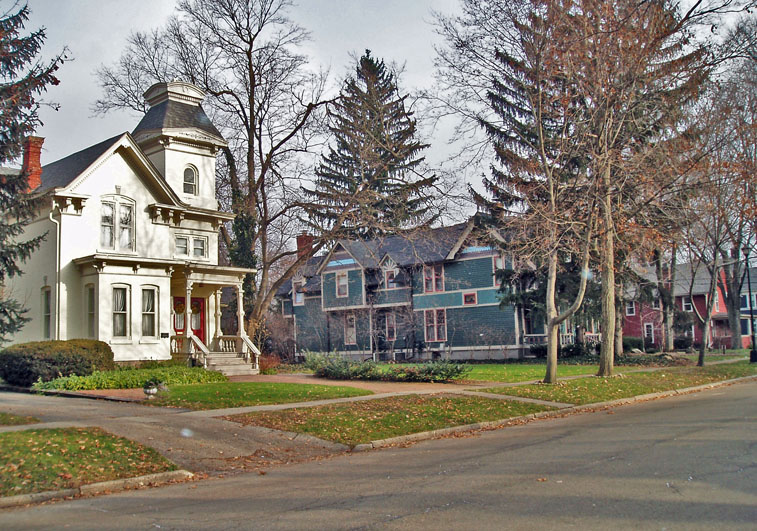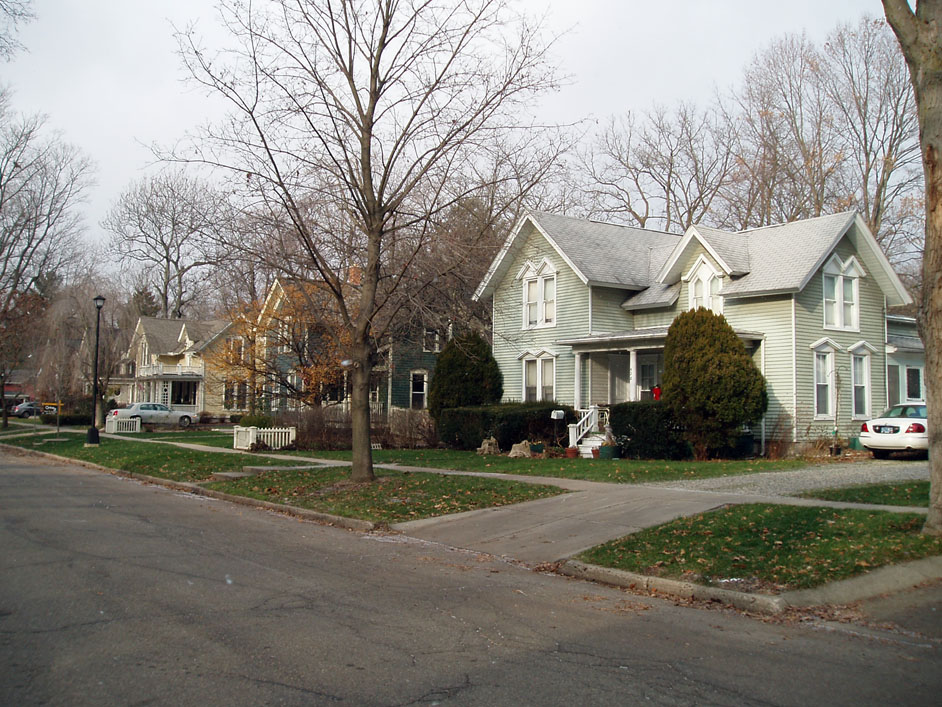

The northwestern corner of Wayne County was first settled
in 1823 when people came from Otsego, New York They were attracted by land
that sold for as little
as $1.25 per acre. Gradually, this area became a farming, milling and manufacturing
center. The foundation for Michigan’s tremendous industrialization developed
when the state’s pine forests were cut and then turned into manufactured
goods. Northville’s growth was fostered when Robert Yerkes, in the mid
Nineteenth Century, established the Globe Furniture Company to produce furniture
for churches and schools. Population growth was sufficient for Northville to
become a chartered village in 1867 and then, 31 years later, the northern part
of Plymouth Township split off to become Northville Township.
This city’s historic district includes at least 73 buildings.
Most of them are homes, but there are also churches and commercial buildings.
Many
of this historic district’s homes are Greek Revival in style and were
 constructed between 1860 and 1890. Presumably, these were residences for the
owners and higher-level administrators of the milling and manufacturing firms
and for Northville’s professional workers.
constructed between 1860 and 1890. Presumably, these were residences for the
owners and higher-level administrators of the milling and manufacturing firms
and for Northville’s professional workers.
Gothic architecture dominated in the design of large buildings—especially ecclesial buildings—in the Middle Ages throughout northern Europe, but then its popularity waned. If you think about the earliest impressive buildings constructed by the infant US government, you realize that none of them were Gothic in style. Rather they were Classical in style, many of them inspired by what was known of the architecture of ancient Greece and Rome. A distinct Gothic style of design emerged in northern Europe in the Medieval era. In the mid-Nineteenth Century, architects and those who wrote about design, found great inspiration in the Gothic style that had been out of mode for two or three hundred years. They argued that the Gothic buildings reflected Europe’s greatest architectural achievements. As a result many governmental and university buildings in England during the long reign of Queen Elizabeth throughout the second half of the Nineteenth Century were Gothic in style, hence the term Victorian Gothic.
When applied to residences, those who worked in the Victorian
Gothic style used many arches, gables, porches and rounded windows, rather
than square or
rectangular ones. There was also an emphasis upon elaborately decorating the
front of the home. Medieval Go thic cathedrals were decorated with immense arrays
of delicate stone tracery. Stonework of that magnitude was not appropriate
for homes and, because of the increased in the cost of labor, it would have
been impossible to pay the large teams of stone carvers that would have been
needed in the age of Queen Victoria. Victorian Gothic designers found an excellent
substitute—elaborate tracery done in readily-available wood. If you
look at the many Victorian Gothic homes in Northville’s Historic District,
you will see numerous bargeboards hanging from gables and many porch decorations
with elaborate wooden tracery. Indeed, when looking at some of these homes,
you begin to think that designers were a bit too much pleased by their ability
to add wood decorations to the front of homes.
thic cathedrals were decorated with immense arrays
of delicate stone tracery. Stonework of that magnitude was not appropriate
for homes and, because of the increased in the cost of labor, it would have
been impossible to pay the large teams of stone carvers that would have been
needed in the age of Queen Victoria. Victorian Gothic designers found an excellent
substitute—elaborate tracery done in readily-available wood. If you
look at the many Victorian Gothic homes in Northville’s Historic District,
you will see numerous bargeboards hanging from gables and many porch decorations
with elaborate wooden tracery. Indeed, when looking at some of these homes,
you begin to think that designers were a bit too much pleased by their ability
to add wood decorations to the front of homes.
This is an attractive and prosperous historic district. Most of the infill homes fit well with the Victorian Gothic structures. One of the classic homes, an Italianate residence dating from 1882 at 501 West Dunlop, is now a bed and breakfast—The Fraser Inn. The schools and commercial buildings do not detract from the ambiance and appeal of the Northville Historic District.
Style of architecture: Many of the residences are small to large sized Gothic
Revival structures.
Dates: Many of the architecturally significant residences were built between
about 1860 and 1880 but attractive in-fill housing was constructed more recently.
City of Northville Historic District: Northville City Council designated this
historic district in 1974.
State of Michigan Registry of Historic Sites: P25,338; Listed: December 11,
1970
State of Michigan Historical Marker: No marker has been put in place.
National Register of Historic Places: Listed July 31, 1972
Website for Northville Historic District: http://www.ci.northville.mi.us/Community/HistoricDistrict/HistoricDistrictOverview.htm
Use in 2006: Primarily an up-scale residential neighborhood with some commercial
activity.
Books about history of Northville: Northville: The First One Hundred Years
by Jack W. Hoffman. Published in 1976
Early Northville by Laura Smyth Hixson (Northville: Mich: Northville Historical
Society, 1982.
Photographs: Ren Farley, December 2, 2006